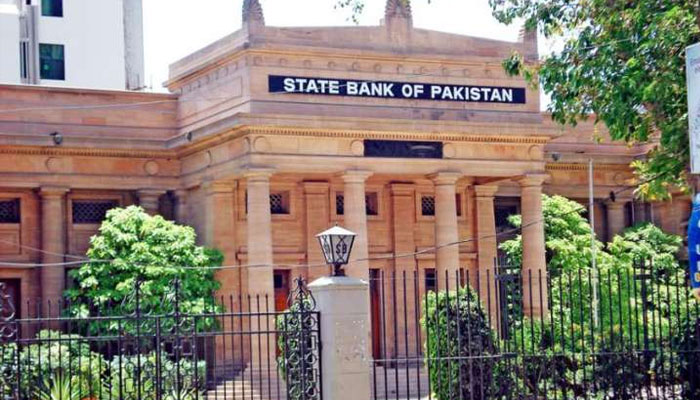State Bank cuts interest rate by 100bps to ease virus-led downturn
KARACHI: The State Bank of Pakistan (SBP) on Thursday cut its benchmark rate for the fifth time this year to a two year low of 7 percent following an unscheduled meeting of its policy committee as it expects a bigger annual contraction in economy due to the fallout from the coronavirus pandemic.
“The monetary policy committee (MPC) decided to reduce the policy rate by 100 basis points to 7 percent… the inflation outlook has improved further, while the domestic economic slowdown continues and downside risks to growth have increased,” said the State Bank of Pakistan (SBP). “Against this backdrop of receding demand-side inflation risks, the priority of monetary policy has appropriately shifted toward supporting growth and employment during these challenging times.”
The latest cut brought cumulative reduction of 625 basis points in interest rate in the last three months as coronavirus shutdown caused growth to contract 0.4 percent during the current fiscal year. The official estimate was in contrast to the SBP’s projection of negative 1.5 percent after the crisis hit in late March.
“Looking ahead, the economy is expected to recover gradually in FY21, supported by easing lockdowns, supportive macroeconomic policies and a pick-up in global growth,” said the SBP. “However, risks are skewed to the downside and the recovery will depend critically on the evolution of the pandemic both in Pakistan and abroad.”
The cut was widely anticipated in the market considering the inflation downtrend.
“This was expected in the July monetary policy announcement and has happened earlier than expected,” said BMA Capital Executive Director Saad Hashmi. “This step should bode well for the country’s growth prospects and stock market sentiments.”
The SBP said headline inflation declined further to 8.2 percent in May on the back of the recent cut in diesel and petrol prices despite a seasonal uptick in food prices associated with the Eid holiday. The FY2020/21 budget is also expected to be neutral for inflation as the freeze on government salaries, absence of new taxes, and lower production cost from reduced import duties should offset the decline in subsidies in some sectors.
“While supply shocks could create some volatility in inflation, the MPC felt that these are likely to be transitory given weak domestic demand, such that monetary policy should generally look past them,” it said. “Given the absence of demand-side pressures, average inflation could fall below the previously announced range of 7-9 percent for next fiscal year. … real rates on a forward-looking basis (defined as the policy rate less expected inflation) would be kept close to zero, which is appropriate under the current circumstances.”
The State Bank said with approximately Rs3.3 trillion worth of loans due to be re-priced by early July 2020 this was an opportune moment to take action from a monetary policy transmission perspective. “In this way, the benefits of interest rate reductions would be passed on in a timely manner to households and businesses.”
Brokerage Arif Habib Limited said immediate impact of interest rate cuts would curtail interest expense of banks due to immediate downward repricing of savings deposits. "Monetary easing in the long term tends to impact net interest margin of the banking sector adversely," it said in a flash note.
The SBP said the decline in large scale manufacturing deepened to 41.9 percent year-on-year in April, when lockdowns were still in place. In May, high-frequency indicators of activity such as cement dispatches, automobile sales, food and textile exports, and oil sales also continued to contract, although mostly at a lower rate than in the previous two months.
The SBP said the current account swung into surplus in May on the back of a reduction in the trade deficit and a pick-up in remittances compared to the previous month. Meanwhile, portfolio outflows slowed considerably compared to the previous two months and FDI has been resilient, nearly doubling to $2.4 billion so far in FY2020 compared to the same period last year. SBP reserves declined to $9.96 billion as of 19th June 2020 largely due to debt repayments. However, since then, SBP has received fresh disbursements from multilateral agencies including around $725 million from World Bank and $500 million from ADB, and another $500 million is expected shortly from the Asian Infrastructure Investment Bank.
The State Bank said the flexible exchange rate has played its valuable shock absorber role, helping cushion the economy from the tightening of financial conditions associated with capital outflows from emerging markets and deteriorating global sentiment.
“The depreciation in the rupee has been lower than in many other emerging markets, reflecting the increased reserve buffers accumulated over the last year,” it added. “The outlook for the external sector remains stable. Recent data confirms the view that the current account deficit should remain bounded through the Covid-19 crisis due to lower oil prices. In addition, projected official and private inflows are expected to keep the external position fully funded.”
-
 Newborns At Risk: Health Experts Warn Your Baby Could Already Have Diabetes
Newborns At Risk: Health Experts Warn Your Baby Could Already Have Diabetes -
 Sarah Ferguson Updates Her Plans Now That Andrew’s Eviction Is Nine Days Away
Sarah Ferguson Updates Her Plans Now That Andrew’s Eviction Is Nine Days Away -
 Hailey Bieber Sends Cease And Desist To TikToker
Hailey Bieber Sends Cease And Desist To TikToker -
 Kate Middleton Celebrates England Women's Rugby Stars After World Cup Win
Kate Middleton Celebrates England Women's Rugby Stars After World Cup Win -
 Kris Jenner Dubs Chicago West Her 'sweet Angel' As She Turns Eight
Kris Jenner Dubs Chicago West Her 'sweet Angel' As She Turns Eight -
 Josh Charles Credits Taylor Swift For His, Ethan Hawke’s Moon Person Trophies
Josh Charles Credits Taylor Swift For His, Ethan Hawke’s Moon Person Trophies -
 Jodie Foster Voices Opinion About 'misogyny'
Jodie Foster Voices Opinion About 'misogyny' -
 Virginia Madsen Remembers Late Brother Michael Madsen Six Months After His Death
Virginia Madsen Remembers Late Brother Michael Madsen Six Months After His Death -
 Emilia Clarke Reveals Real Price Of Playing Daenerys In 'Game Of Thrones'
Emilia Clarke Reveals Real Price Of Playing Daenerys In 'Game Of Thrones' -
 Ex-Chicago Mayor Hit With Lawsuit Over Unpaid Credit Card Bills
Ex-Chicago Mayor Hit With Lawsuit Over Unpaid Credit Card Bills -
 Andrew Risks His Relationships With Princess: ‘She’s Supporting The Abused And It’s Festering’
Andrew Risks His Relationships With Princess: ‘She’s Supporting The Abused And It’s Festering’ -
 Harry Styles Unveils New Album After Cryptic Posters Spark Fan Frenzy
Harry Styles Unveils New Album After Cryptic Posters Spark Fan Frenzy -
 Prince Harry Ready To Return To The UK To King Charles But It’ll Depend On How THIS Goes
Prince Harry Ready To Return To The UK To King Charles But It’ll Depend On How THIS Goes -
 Why Isn't King Charles Mourning Death Of His Father's First Cousin?
Why Isn't King Charles Mourning Death Of His Father's First Cousin? -
 Nicole Richie Breaks Silence On Her Daughter's Name Change
Nicole Richie Breaks Silence On Her Daughter's Name Change -
 Truth Behind Chris Noth, Sarah Jessica Parker's Ongoing Feud Revealed
Truth Behind Chris Noth, Sarah Jessica Parker's Ongoing Feud Revealed




